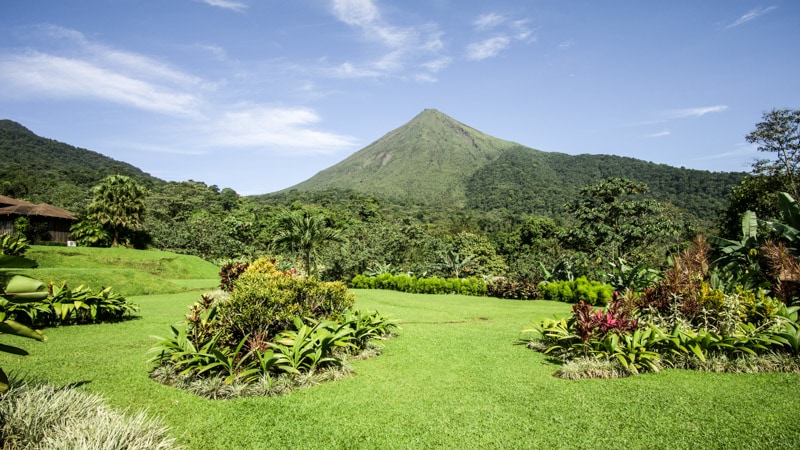
Costa Rica. After years of wanting to travel to this beautiful country, I finally made it. Before my trip, I read many online articles, reviews, tips, and complaints from past travelers to Costa Rica. From tipping, to car rentals, to driving, I read it all. Some good and some bad. I wasn’t sure exactly what to believe.
Now that I have experienced a trip for myself, here are some things you should know if you plan to visit Cosa Rica.
Table of Contents
1 – Most places accepted U.S. Dollars and Costa Rican Colones
I wish I had brought more U.S. dollars along with me on this trip.
I was surprised with how many hotels, restaurants, tourist sights, and tours accepted both dollars and colones. Most restaurants displayed food and drink costs in both currencies on the menu and on the bill at the end of the meal.
Many ATMs also dispensed both currencies including those at airports.
2 – Some restaurants and bars added a service fee and tax to menu prices while others did not
Many restaurants added a 10% service charge and an additional 13% tax to the total bill. At the bottom of the menu, you may see if these fees are included or not. If nothing is displayed, you can just ask your server if the service charge is included.
If the fees are included, you do not have to tip extra for service unless you wish. If the fees are not included, you only need to add on about 10% for service, or whatever you would like.
3 – The roads were not as bad as you think (if you stick to the main roads)
Driving in Costa Rica was not as bad as some have claimed, as long as you stick to the main roads that are paved.
If you will be traveling around the country and exploring areas further away from San Jose, you will most likely encounter dirt roads and roads with potholes. Anytime you turn off the main road, like looking for a waterfall or hiking trail, be prepared for a dirt road.
Driving on these dirt roads is possible but often difficult with a low clearance vehicle. If you rented a low clearance vehicle, like I did, then you will have to drive slowly on these roads. Always watch out for speed bumps, rocks, and potholes on any road.
If you are a slow driver, no need to worry about tailgaters as most drivers behind you will just pass you on the left.
Try not to stray into rural areas if you don’t have a four-wheel drive vehicle. Don’t do what I did. I made one wrong turn on the way from San Jose to Manuel Antonio National Park and ended up on a sketchy dirt and rock road with steep climbs. I was beyond scared that I was going to damage my rental car. Luckily, I made it out with no car damage.
Even though I did not need an SUV, in the end, I wish I spent the extra $100 for the higher clearance and less stress while driving.
Some other things you will encounter while driving in Costa Rica are two lane roads, narrow bridges, lots of slow motorcycles, toll booths, and animals on the road.
4 – Know your route between point A and point B prior to driving
Always plan your route from the origin to the destination before you hit the road. Without planning, you may end up on a dirt road or get lost.
Don’t just automatically assume that your GPS or Google Maps are sending you in the right direction or on a paved road. Know which roads you will be driving on before. This will ensure that you stay on paved roads.
5 – It takes much longer than you think to get from point A to point B
Whatever Google Maps tells you, add on an extra hour to your journey time. With uncertain road conditions, 2 lane highways, traffic, and construction zones, you will soon figure out that getting from one destination to the next takes a lot longer than planned.
Just slow down, take your time, and enjoy the beauty of the country as you drive through it.
6 – Most people spoke English
The majority of workers at bars, restaurants, and stores spoke at least some English.
With that said, it’s always great to try to speak Spanish with the locals even if you barely know a word. Learning a few words of the local language, no matter where in the world you may be, is a great way to connect and immerse yourself in the culture of the country you are visiting.
7 – Car rental insurance options can be confusing
I read many horror stories about renting a car in Costa Rica. I was seriously nervous. In the end, everything turned out alright.
Whenever I rent a car, at home or in a foreign country, I always decline the insurance. My credit card covers the Collision Damage Waiver (CDW) insurance.
In Costa Rica, things are a little different.
From what I understood and read online, I could decline the CDW coverage but it was required that I pay for a Supplementary Liability Insurance (SLI). To avoid any troubles, I paid for this SLI insurance online at home before my trip. It did cost me an extra $20 a day, but from what I understood, the SLI coverage was mandatory in Costa Rica and was enforced by the government.
If your car rental company adds this coverage, know that they are not trying to charge you extra, but that it is mandatory.
Also, I rented with Budget Rent a Car from the airport in San Jose. Other than an expected credit card deposit, that was removed after returning the car, I had no problems or hidden charges to report. I would recommend Budget Rent a Car in Costa Rica.
8 – Some roads have toll booths
If you will be driving in the San Jose area, be sure to keep small change or bills on you as you may encounter toll booths.
Toll fees are usually inexpensive. Expect to pay around 300-500 colones for an automobile or a little less for a motorcycle.
When you encounter a toll both, make sure you drive through the correct lane for those paying with cash (via manual) instead of the lanes for those with quick pay passes (exclusivo).
9 – Gas is full service
I live in California where I have to pump my own gas. Yes, the horror.
Gas stations in Costa Rica are full service. You just pull up to the pump and an attendant will pump your gas for you and let you know when it is full.
Fuel in Costa Rica cost me about 600 colones per liter for regular unleaded. Most gas stations accepted credit cards along with colones.
10 – Tap water is generally safe to drink
This was one that surprised me.
For the first part of my trip, I avoided tap water at all costs. I even avoided ordering any drinks with ice in them. At a restaurant in La Fortuna, I was told that the tap water was safe to drink and that I had nothing to worry about.
Not believing it, I pulled out my trusty phone and looked it up on Google. I found that tap water in Costa Rica was safe to drink and actually high quality. So, I believed what Google told me and I drank away. It actually tasted great and I did not get sick.
The only places it was not recommended to drink tap water or ice was in Limón and Puntarenas.
At my hotels though, for some reason, I just stuck to bottled water. It was also great to have bottled water for trips to the beach or on hikes.
11 – Most of the country is beautiful, green, open land
Almost the entire country of Costa Rica is open green land. If you have a car rental, you will be amazed by the beauty of this mesmerizing country.
Once outside the larger cities and towns, you will be wowed with endless views of mountains, rivers, and green pastures filled with roaming cows and horses. For such a small country, it was quite amazing to see how much of the land was untouched and undeveloped.
Another thing I noticed was many homes and open land for sale. You will see Se Vende (for sale) almost everywhere, so if you are looking to quit that job and move to Costa Rica and retire, now is your time.
12 – There are bugs and insects everywhere
Going for a hike? You will encounter bugs. Inside your hotel, might find bugs. At many restaurants, you may see a bug on the ground or flying by. Almost everywhere you look, you will find a bug or insect. This might seem strange or gross to most but Costa Rica is a tropical environment and insects are a part of life.
Don’t forget to bring the bug spray.
13 – There is wildlife everywhere
One of the coolest thing about Costa Rica are all the animals and wildlife you will encounter.
No matter where you are, you will be surrounded by wildlife. Almost every morning of my stay at Lomas del Volcán in La Fortuna, I would be greeted by a White-nosed coati. This friendly little creature, in the raccoon family, seemed to always be on the lookout for food. Other animals I encountered were monkeys, sloths, lizards, and iguanas.
Always have your camera ready in case you encounter an animal.
Also, watch out for animals on the road such as dogs, frogs, and other wildlife. On multiple occasions, my car rental was chased after by dogs.
14 – Weather can vary greatly by the area and by the minute
If you travel to tropical climates often, then you know that the weather forecast is almost always partly cloudy with a chance of thunderstorms. This is no different for Costa Rica where the weather forecast is hard to predict.
Weather in Costa Rica can vary by location. In Manuel Antonio it can be 90 degrees and miserably humid. A few hours away in the higher elevations of La Fortuna, the weather can be quite pleasant and even cool at night. Further southwest in Liberia, the weather can be scorching hot with no rain for days.
Weather in Costa Rica can also change by the minute. Often, it would be sunny, then cloudy, then raining, then sunny again all within a few minutes. When it rained, which was almost every day, it would rain heavy for a few minutes then clear out.
Plan on rain, hope for the sun. Even if it rains, it will be refreshing and hopefully clear out fast.
15 – Many things you think should be free cost money
This may come as a surprise to many people, but things that are usually free in other parts of the world often cost money in Costa Rica.
Want to check out Playa Biesanz in Manuel Antonio National Park. That will cost you 2,000 colones to access. La Fortuna Waterfall will set you back $11 a person. Want to do the Cerro Chato hike in Arenal Volcano National Park? You will have to pay $8 per person to gain access to the trail head at the Arenal Observatory Lodge.
Even with the higher costs, the experiences are well worth the costs of admission.
16 – Hotel bathrooms are massive
Ok, this might sound strange but all four hotels I stayed at on my trip had a bathroom the size of my bedroom back at home in California.
In general, all of my hotel rooms were large, which was a great surprise considering that I usually try to stay at cheaper hotels which allow me to save money and then travel more. So, if you book a room in Costa Rica, expect a large room and a large bathroom.
17 – Hotel Wi-Fi is not reliable
A limited connection is a daily occurrence. It’s 2015, you would think that hotels around the world would figure out their Wi-Fi issues by now, but in Costa Rica, this was not the case.
All four of my hotels had Wi-Fi issues. It would work for a couple hours, then go out. After a call to the front desk, the router would be reset. All would be well for another hour or so, then poof, the connection was gone once again.
At the Best Western Las Espuelas in Liberia, the Wi-Fi only worked for about 30 total minutes in 24 hours. When I asked the front desk about the issue, I was told that nothing was wrong with the connection but that it was just slow.
If you plan to get work done in a hotel here, you might have to have a lot of patience.
18 – When departing from the airport on your flight home, you have to pay a departure fee
All passengers departing from an airport in Costa Rica will have to pay a $29 departure fee. If you plan to use your credit card, also know that the fee is charged as a cash advance. Many credit card companies charge extra for cash advances. Visa charged me an extra $10 but took it right off when I called up to complain. Not a great way to end my vacation.
So if you can, pay the fee in cash.
Last Updated on January 15, 2023


Hello, nice post.
I will go to Costa Rica next week and i have a doubt.
The tolls roads accept Dollars?
The gas station accept Dollars?
Thank you
Andre,
Great questions.
The toll roads in Costa Rica that I passed through did not accept U.S. Dollars, only Costa Rican Colones.
For gas stations, I only used credit cards, but I do believe that most gas stations accepted dollars. When paying with dollars there will be a conversion rate to colones, which can be favorable or unfavorable. When paying with cash, make sure to get a receipt and check over it before you leave the station to make sure everything is correct.
-Anthony